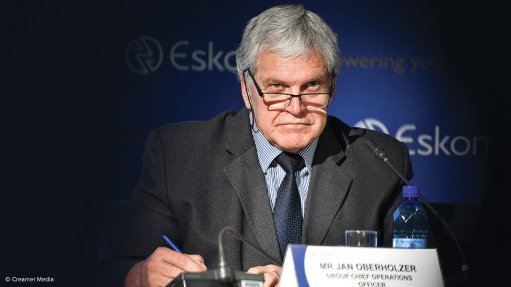
Eskom COO Jan Oberholzer
Photo by: Creamer Media's Dylan Slater
State-owned power utility Eskom on Wednesday said it was unlikely that there would be any load-shedding over the next seven months as the utility’s generation performance was starting to improve.
The embattled utility had managed to avoid load-shedding for 164 consecutive days, with an average energy availability factor of 70.4% as at the end of August, COO Jan Oberholzer said.
Eskom’s nine-point generation recovery plan was on track, yielding some positive results and sustained good performance from transmission and distribution networks, despite an increase in illegal connections, vandalism and equipment theft.
“There has been a significant contribution from both commercial and noncommercial units among the power stations,” added Eskom chairperson and acting group CEO Dr Jabu Mabuza.
Addressing media at the utility’s latest Status of the System briefing, he explained that three noncommercial units from Medupi and Kusile had delivered more 1 000 MW in the last six months, with Kusile Unit 3 synchronised to the national grid on April 14 and Medupi Unit 3 having reached commercial operation on July 5.
Medupi’s Unit 1 was also synchronised to the grid on August 27.
This meant that, for the first time, all six Medupi units had been connected to the grid.
Further, the Cahora Bassa hydropower plant, in Mozambique, had been successfully recovered, with 1 200 MW of imported renewable energy added to the grid, and Kriel Unit 2 and Matla Unit 5 were returned to service, adding an aggregate 1 050 MW to the grid, said Oberholzer.
Generation unit breakdowns were maintained at below 9 500 MW for the bulk of the winter period, and less diesel was used than planned, with year-to-date totals reaching R1.4-billion – well below the budgeted R5.4-billion.
“While winter showed positive results, our focus has now shifted to effectively dealing with the summer period,” Mabuza continued.
Eskom is planning for 5 500 MW of capacity to be maintained during the summer period and it will aim to keep unplanned plant breakdowns below 9 500 MW during the period to prevent load-shedding.
Demand for the period is expected to be about 30 000 MW.
However, Eskom outlined three possible unplanned breakdowns scenarios – 8 500 MW, 9 500 MW and 10 500 MW – saying these unplanned outages could trip the utility up and send the country into load-shedding.
Should Eskom maintain breakdowns at below 9 500 MW, a minimum amount of diesel would be required to avoid load-shedding.
Breakdowns of between 9 500 MW and 10 500 MW would increase the risk of load-shedding, as well as the amount of diesel needed by the utility as it tries to avoid load-shedding.
Any unplanned breakdown in excess of 10 500 MW, however, would mean that load-shedding can no longer be ruled out and a high level of diesel use will be required to keep the lights on.
“The use of pumped storage and open-cycle gas turbine diesel generation to supplement capacity is necessary but consistent use could result in a rapid depletion of emergency resources, which could lead to load-shedding,” Oberholzer warned.
The summer plan, however, balanced the need for increased maintenance against the risk of unreliable plant performance, assured Mabuza.
Full load losses, partial load losses, slips and major incidents have been the major contributors to an increase in unplanned losses.
The Kendal, Arnot, Tutuka, Medupi and Kriel power stations contribute about 62% of the total partial load losses to date, with the main contributors being the draught plant, gas cleaning, milling plant, feed water and ash plant, accounting for 79% of the trips reported in the period to date.
Other risks that could lead to load-shedding, in addition to new trips and plant breakdowns, include high vacuum levels owing to high temperatures; delays in returning plant to service after a planned outage; any “macro factors” such as protests, adverse weather or strike action that could further impact on plant performance; excessive use of emergency resources, such as diesel and hydropower, for consecutive days; increased theft and vandalism; and severe weather conditions impacting on imports.
Meanwhile, Eskom assured consumers that it had resolved its coal stock dilemma.
“Coal stockpiles remain at healthy levels with only one power station, Kriel, currently below the National Energy Regulator of South Africa’s Grid Code requirement,” noted Oberholzer.
However, by year-end, Kriel’s current 15.6-day stockpile will be on par with the rest of the power stations, he pointed out.
“We have made notable strides in addressing coal stock challenges. As you will recall, ten of the 15 coal-fired power stations were below the prescribed 20 coal stock days as per the Grid Code requirement,” Mabuza said.
In November, Eskom reported that ten coal-fired power stations were below the Grid Code requirement, with five below ten days.
As at September 2, the coal stock level at most power stations, but excluding Medupi and Kusile, was at 50 days.
Good progress had also been made with coal quality and measures were in place to mitigate rainfall, including compacted dry strategic stockpiles and wet coal handling procedures.
“While the risk of load-shedding always exists, we remain confident that we are on a direct course to keeping the lights on for South Africa this summer,” Mabuza concluded.